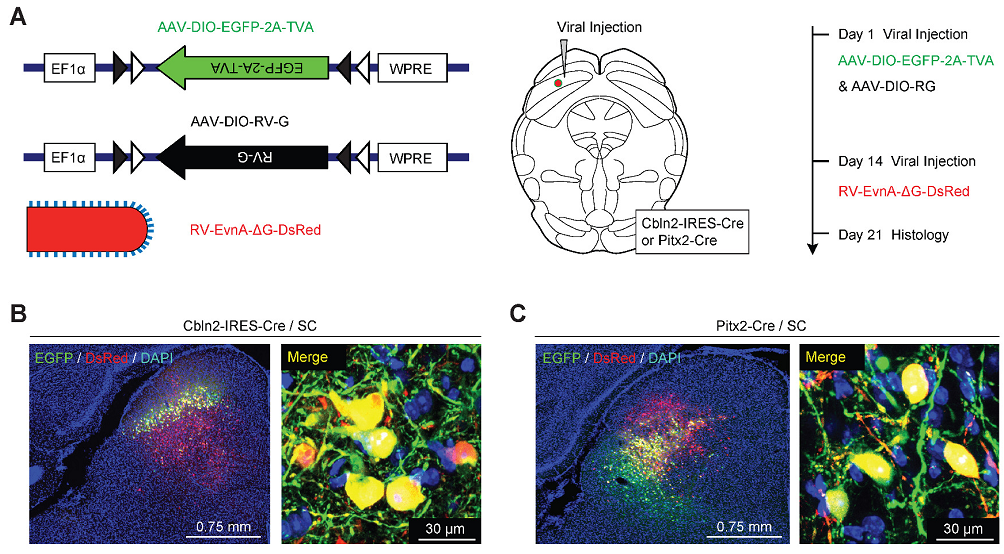Rabies-virus system was used to accurately visualize layer-specific neuronal projection patterns from the SC to downstream brain regions. (From
BrainVTA)
The viruses used in this article from BrainVTA are in the table below
|
Tracing Helper |
PT-0062 AAV-DIO-EGFP-2A-TVA
PT-0023 AAV-DIO-RG |
|
RV |
R01002 RV-SAD19-DG-dsRed (EnvA) |
Zhiyong Xie, Mengdi Wang, Zeyuan Liu, Congping Shang, Changjiang Zhang, Le Sun, Huating Gu, Gengxin Ran, Qing Pei, Qiang Ma, Meizhu Huang, Junjing Zhang, Rui Lin, Youtong Zhou, Jiyao Zhang, Miao Zhao, Minmin Luo, Qian Wu, Peng Cao, Xiaoqun Wang
Pub Date: 2021-07-28,
DOI: 10.7554/elife.69825,
Email: sales@brainvta.com
Sensorimotor transformation, a process that converts sensory stimuli into motor actions, is critical for the brain to initiate behaviors. Although the circuitry involved in sensorimotor transformation has been well delineated, the molecular logic behind this process remains poorly understood. Here, we performed high-throughput and circuit-specific single-cell transcriptomic analyses of neurons in the superior colliculus (SC), a midbrain structure implicated in early sensorimotor transformation. We found that SC neurons in distinct laminae express discrete marker genes. Of particular interest, Cbln2 and Pitx2 are key markers that define glutamatergic projection neurons in the optic nerve (Op) and intermediate gray (InG) layers, respectively. The Cbln2+ neurons responded to visual stimuli mimicking cruising predators, while the Pitx2+ neurons encoded prey-derived vibrissal tactile cues. By forming distinct input and output connections with other brain areas, these neuronal subtypes independently mediate behaviors of predator avoidance and prey capture. Our results reveal that, in the midbrain, sensorimotor transformation for different behaviors may be performed by separate circuit modules that are molecularly defined by distinct transcriptomic codes.
 Figure 1. Retrograde tracing of Cbln2+ and Pitx2+ superior colliculus (SC) neurons using rabies virus (RV).
Figure 1. Retrograde tracing of Cbln2+ and Pitx2+ superior colliculus (SC) neurons using rabies virus (RV).
In the present study, by performing high-throughput and circuit-specific single-cell transcriptomic analyses of cells in the SC, the authors systematically studied the molecular markers of SC neurons, sensory response properties, input-output connectivity, and their behavioral relevance. They found that Cbln2+ and Pitx2+ SC neurons form part of two distinct sets of circuit modules for sensorimotor transformation related to behaviors of predator avoidance and prey capture. The data suggest that sensorimotor transformation for different behaviors may be performed by separate circuit modules that are molecularly defined by distinct transcriptomic codes.
BrainVTA offers viral vector construction & virus packaging services for AAV, LV, RABV, PRV, HSV and VSV that help researchers explore questions about genes, neurons, circuitry structure, function of brain network, mechanism and treatment of diseases.
If you have any needs, just email us at
sales@brainvta.com.
